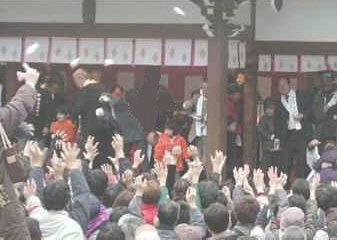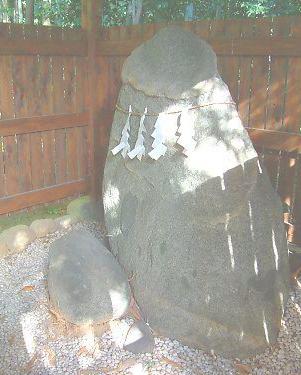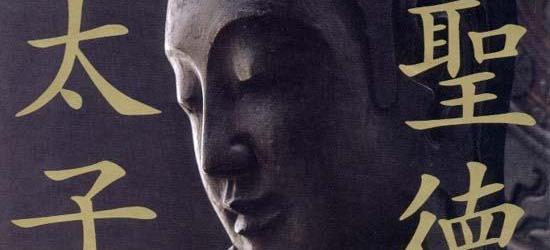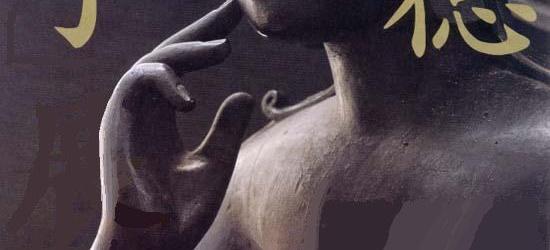| |||||||||||

 |
The mystery of
Ape Stone by Akira Kato
August 2, 2003
Ape Stone
Ape stones represent personas
The shaven-headed statue without a demon on its back represents a “priest”. The full-length statue of Sanno avatar with a penis represents a “person”. The man with a hat takes a role of a noble man, representing an “old man”. Other images assume men of lowly birth such as “humble farmers”. The stone image of a Buddhist priest without a demon on his back acts as a clergyman with the supernatural power that eliminates a demon, and he probably assumes the hero of this drama. In other words, this drama serves as a sacred stage-play at the place of religious service, and the strange looks of each ape stone represent an extremely deformed mask of a character of the play. An ape stone with a phallus has something to do with Dionysos?
Let’s talk about the above “phallic stone”, which not many people know but which seems so famous in the dilettante circle as one of the mysterious stones in Asuka. In any case, scholars seldom talk about this phallic stone probably because they don’t consider this to be academic. However, if you think of this stone with regard to the ancient Greek history, it appears quite intriguing. Therefore, let’s get into the details of the mystery of this phallic stone. They say that it originally stood straight. Please compare its size with the private house in back in the above photo. If it stood straight, it would easily reach the haed of an adult man and beyond. Although it looks like a square pillar, the tip has a round border with a slit in the center. It really resembles a phallus, doesn’t it? By the way, the residents in this region call the hill on the other side of the Asuka River
“Fuguri Yama” or scrotum mountain. “Fuguri” is
a seldom-used word that
sounds archaic with a touch of grace. I’ve never used it in my
conversation, and don’t think
there is an equivalent word for this in English. “Scrotum” sounds too anatomical.
“Sac” sounds too colloquial and slangish. If you aren’t a native Japanese and
pronounce this word before the natives, they would probably never understand you.
Fugu is a globefish or swellfish, and considered to be one of the best delicacies, and deadly. Some dozen years ago, a famous kabuki actor cooked it by himself and ate it with rapture to death—literally. It is so poisonous that you have to pass the exam (need a licence) to cook it in Japan. Anyway, if you go to the nearby Asukaza Shrine, you can see a number of smaller phallic stones.
Asukaza Shrine turns out a fascinating object to study. Although it is not well-known among ordinary people, it has a high-ranking status and has enshrined four famous persons—Kotoshiro-nushi-no-mikoto, Takabi-musubi-no-kami, Asuka-mikahi-no-hime-no-mikoto, Oomono-nushi-no-mikoto (Okuninushi-no-mikoto). Although Oomono-nushi-no-mikoto is enshrined in Miwa, Yamato, scholars regard him as the same person as Okuninushi-no-mikoto of Izumo. The last deity yielded the present Imperial Household’s ancestor the country of Yamato, and moved to Izumo. He left his daughter Mikahi-no-hime-no-mikoto behind to protect and pray for the Imperial Household. She was actually taken as a hostage so that Okuninushi would not revolt against the Imperial family. In short, Asukaza Shrine was built to comfort the spirits of the defeated king and his retainers of the previous dynasty. These four deities have formed an anti-mainstream faction while Sun Goddess (Amaterasu-Oomikami) remains the mainstream. These deities of anti-mainstream could work as a key to solve the mystery of a phallic stone. This is described in the next page. Because those deities once had a great power, the succeeding dynasty allowed the strange ritual called “Onda-sai” or imperial paddy-field festival to continue at this shrine. This ritual or festival, considered ethnologically peculiar, is held on the first Sunday in February. A tengu (red-faced, long-nosed goblin) and an otafuku (moonfaced woman) perform a sexual act as man and wife on the stage of Asukaza Shrine. This ritual, known as the strangest of all the rituals, is not taught at school, though this is quite well-known in the dilettante circle. I don’t think none of my history teachers have ever talked about this ritual at school. Why don’t they teach this sort of rituals in history? If they did, their students could find history more interesting and intriguing, and they would be more motivated to study further. It is a pity that most teachers seem to oppose teaching this kind of materials at school in Japan.
In the second part, as you see at right, a tengu and an otafuku come onto the stage as a loving couple. Placed on the woman’s head are two oranges that are substituted as a pair of kanzashi or ornamental hairpin. Actually, you see two actors and one actress. Why three?—you wonder. Mind you, they won’t perform a threesome. An additional actor serves as a go-between. He would rather act as a clown so that the intercourse scene could not look too real. If only two persons imitate a sexual act on the stage, it might look too much with reality. So, this elder go-between appears as funny as possible so that the stage mixes the play with laughter. With this comical personality, the whole ritual advances like a comdy. The classical drama of Greece may be related to this ritual.
In the above picture, the older man appears to mount the tengu, but he does NOT engage himself in the threesome. Instead, he tries to help the couple with a series of advises in a comical way, of course, so that the audience could enjoy the show with a roar of laughter. Look at the shinto priests and elders on the stage. They seem to enjoy the ritual more than anybody else.
The shinto priests as well as the visitors consider this paper to be auspicious because, in Japanese, “wiping paper” means exactly the same as “luck-inviting god” phonetically. The elder then throws out thousands of pieces of such paper to the visitors as shown below. If a visitor obtains one of such sheets, he or she can (so believed) produce a lot of children and invite fortune to the home. The visitor, therefore, try to get one by all means with a great deal of zeal, gusto and laughter. They fight and scramble for this paper.
But, the phallic stone has something to do with this ritual? The giant phallic stone in the above picture is not located in the compound of Asukaza Shrine but on the nearby roadside. At a glance, therefore, it seems to have nothing to do with the ritual. As shown in another picture, however, the shrine has smaller phallic stones on its compound, though they appear insignificant. In any case, phallic stones are definitely related to the ritual.
Why?
The giant phallic stone But how about the Dionysos myth? Does the the above ritual have
anything to do with Dionysos?
Fertility Rituals
at Asukaza Shrine
Related Links
Emperors Temmu and Tenchi Emperor Tenchi was assassinated.
The secret of Joue's birth Fujiwara Kamatari and his eldest son (定慧)
The United Kingdom
of Immigrants (渡来人) Fujiwara Kamatari and Rikutou (六韜) Why don't books older than Kojiki remain? Machiavelli would be surprised to see the Bible of the Fujiwara Clan
| ||||||||||
| |||||||||||




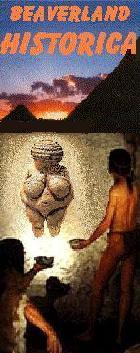



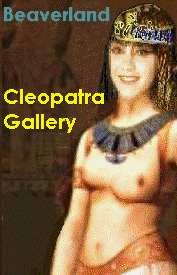








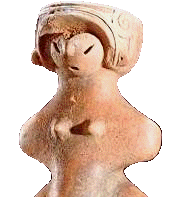


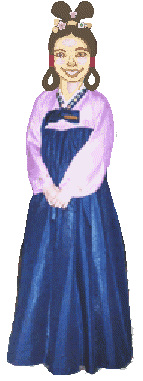
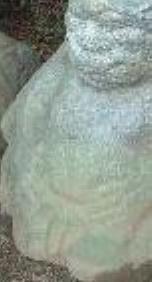 In this theory, each ape stone takes a role in a drama.
In this theory, each ape stone takes a role in a drama.
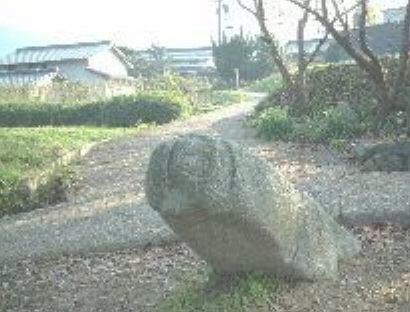
 Maybe, they would say, “Oh, you mean a globefish?”
Maybe, they would say, “Oh, you mean a globefish?”


 The ritual consists of two parts. In the first part, the shinto priest
transplants rice seedlings by likening the stage with a paddy field.
It seems to symbolize the Yayoi culture in short. You can see this kind of
ritual in various places in Japan.
The ritual consists of two parts. In the first part, the shinto priest
transplants rice seedlings by likening the stage with a paddy field.
It seems to symbolize the Yayoi culture in short. You can see this kind of
ritual in various places in Japan.

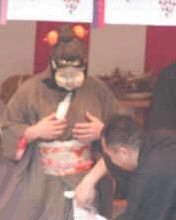 To popularize the ritual further, the elders come up with strange gifts to
give the visitors. When the couple finish their lovemaking, one of the elders
comes up
to the otafuku and help her clean up the mock semen oozed out around
her pussy.
The elder wipes out the mock semen with a piece of light-pink paper.
To popularize the ritual further, the elders come up with strange gifts to
give the visitors. When the couple finish their lovemaking, one of the elders
comes up
to the otafuku and help her clean up the mock semen oozed out around
her pussy.
The elder wipes out the mock semen with a piece of light-pink paper.
